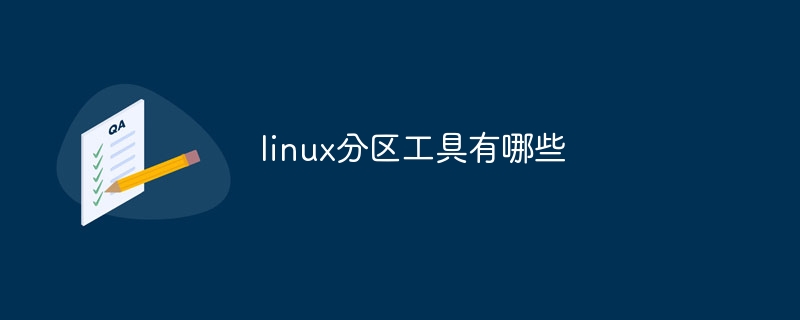
Linux partitioning tools include: 1. GParted, the most popular disk partition manager; 2. KDE Partition Manager, which has all basic functions, such as creating, deleting and resizing partitions; 3. GNOME Disk, which provides It has all the basic functions such as deleting, adding new, resizing and adjusting partitions; 4. FDisk, pre-installed in every Linux-based distribution; 5. GNUparted, a command line utility.

#The operating environment of this article: linux5.18.14 system, dell g3 computer.
Partitions are first created in the Linux operating system during installation, but you can also add, delete, modify and resize partitions at any time after installation. Disk Partition Manager is especially useful for adding new drives or USB When you have a memory stick and have to change its file system, there are various GUI and command line based disk partition managers, we will discuss their usage below and help you choose the best option for you.
GParted is the most popular disk partition manager, it even Comes pre-installed on many Linux distributions, if it is not installed then search in your software center and you will find it, to install this application from the command line you can type the following command in the terminal, depending on your Distro:
For Ubuntu based distributions:
sudo apt install gparted
For Fedora Workstation:
sudo dnf install gparted
For Arch Linux and Arch based distros:
sudo pacman -S gparted
When it starts, it will prompt you for your sudo password for admin authentication , you can also try data rescue if you accidentally deleted some files. It also has a Live CD image that you can burn to disk and then modify your root partition from as well.
This application comes pre-installed in all distributions shipped with the KDE desktop environment, however, if for some reason it is not installed on your distribution, you can always install it from your distribution's software store. If you wish to install it on a distribution with DE other than KDE, just search for it in the Software Center or install it via the command line.
For Ubuntu-based distributions:
sudo apt install kde-partitionmanager
For Fedora Workstation:
sudo dnf install kde-partitionmanager
For Arch Linux and Arch-based Distro:
sudo pacman -S kde-partitionmanager
When you launch it it will ask you for your password to get administrative rights otherwise it will not work properly. It has all the basic functions like creating, deleting and resizing partitions.
This application is provided by default in the GNOME desktop environment and it provides all the basic functions such as delete, add new, resize and adjust Partition. You can even repair partitions or restore disk images using this application.
To install it on your distribution, you can look for GNOME Disk in the Software Center, or install it via the command line, using the following command:
On Ubuntu-based distributions:
sudo apt install baobab
For Arch Linux and Arch-based distributions:
sudo pacman -S baobab
For Fedora Workstation:
sudo dnf install baobab
Fdisk comes pre-installed in every Linux-based distribution. To start it, you must specify the disk you want to manage and sudo permissions. For example:
sudo fdisk /dev/sda
命名要修改的设备时要小心。在使用“”运行fdisk命令之前仔细检查所有已安装的驱动器lsblk。
更多命令选项,按m或参考官方文档页面。但是,如果您不习惯使用命令行工具,您应该坚持使用GUI分区管理器。
它也是一个命令行实用程序,预装在所有Linux发行版中,要从终端启动它,请键入:
sudo parted
要了解如何使用GNUparted,您可以键入help然后按Enter。
我们希望您已经弄清楚您将在方便时使用哪个分区管理器,建议初学者使用GUI工具,但如果您知道自己在做什么,那么CLI工具会更快。
The above is the detailed content of What are the linux partitioning tools?. For more information, please follow other related articles on the PHP Chinese website!